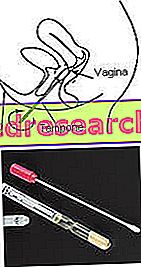Generality
Shoulder calcification consists of the formation of calcium deposits in the tendon tissue of the rotator cuff.

The presence of these concretions causes pain in the affected shoulder (or both, since both sides can be involved simultaneously) and limitation of upper limb movements .
The causes that lead to the development of this pathology are not yet fully known. Shoulder calcification is not a severe disease, but the painful symptom that accompanies it can make the use of the joint impossible, even for the simplest activities.
The disorder can resolve spontaneously, gradually, over a period of months or years. However, chronic shoulder pain may require treatment.
What's this
Shoulder calcification is a disease characterized by the presence of calcific deposits on the rotator cuff tendons . More precisely, the calcium crystals are organized to form concretions at the level of the tissue of the tendons of the muscles which are inserted in the scapulo-humeral articulation (ie the one located between the arm and the shoulder).
The result is an inflammation of the shoulder, which involves intense pain and limitation of movement.
Shoulder: anatomical and functional features
- The shoulder is the joint that joins the arm to the chest . This is formed by the joint of three bones: the humerus (that is, the long bone of the arm), the scapula (which constitutes the posterior part of the shoulder) and the clavicle (located, however, in the front part).
- The bones participating in the shoulder joint are connected to each other through a complex system of soft tissues (muscles, tendons and ligaments) which allow a wide range of movement.
- The active movements of the shoulder are secured by four tendons and as many muscles: this group - called " rotator cuff " as a whole - connects the head of the humerus to the scapula, stabilizes and promotes the activities of the arm.
- The components of the shoulder joint, together with the tendinous and muscular structures that surround them, are concentrated in a space of a few centimeters and are subjected to continuous stresses. The latter are also multidirectional, since the shoulder is also implicated in the movements affecting the muscles of the arms, chest and back.
- The movements of the shoulder are, then, among those that are performed with greater frequency and, precisely for this reason, it is easier for disturbances to arise.
Causes and Risk Factors
The causes of calcification in the shoulder are still not entirely clear. However, multiple factors have been identified that may favor the onset of the disease.
Calcifications are often found along the path of the rotator cuff tendons, particularly in the area where they are inserted into the bone.
Did you know that…
The pathologies of the shoulder often concern the scapulo-humeral joint tendons which, being the structures more subjected to stress and wear, can be affected by inflammation, bursitis and lacerations .
Shoulder calcification: why does it occur?
Shoulder calcification is caused by excessive deposit of calcium salts in the tendon tissue of the rotator cuff. Over time, these concretions form a mass that causes irritation and pain in the joint: by colliding with the affected tendon during arm movement, the collection of calcium salts predisposes to an inflammatory state .
Shoulder calcification can begin for two main reasons:
- The tendon tissue degenerates due to aging and wear and, subsequently, calcific ( degenerative calcification );
- Tendon cells begin to produce calcium due to a process of fibrocartilaginous metaplasia ( calcific tendinopathy ).
Mechanical factors
Calcification may depend on chronic inflammation of the tendon resulting from a situation of continuous overload of the shoulder or from wear related to certain daily movements (heavy work or particularly intense sporting activities).
Furthermore, the precipitation of calcium salts can be the consequence of a local trauma or a lesion of the rotator cuff which, by altering the blood supply to the tendon, causes an alteration of the local pH.
Biological factors
Shoulder calcification can be the consequence of a deterioration of the bachelor-humeral joint favored by lifestyles, habits or pathologies that, by reducing the blood supply, contribute to weaken the tendons, such as: hypertension, diabetes, alcoholism, smoking and Sedentary life.
The predisposition to develop a calcification in the shoulder may also be related to hypercalcaemia, ie to high calcium levels in the blood.
Other aggravating and triggering factors
- The chances of developing shoulder calcifications may increase in the presence of autoimmune diseases and familiarity due to calcium dysmetabolism .
- Shoulder calcification may occur in patients with rotator cuff tear or in people with frozen shoulder or adhesive capsulitis.
- Some scientific researches have hypothesized that the calcification in the shoulder could be correlated with hypothyroidism ; however, the association with such endocrine dysfunction has never been demonstrated.
- Other sources, on the other hand, claim that the calcification on the shoulder is idiopathic, that is, it manifests itself without an apparent reason.
Shoulder calcification: where is it located?
- Shoulder calcification may be unilateral (ie involving only one side of the body) or bilateral . Usually, in right-handed patients, the pathology occurs on the right, while in left-handed patients the onset is mainly on the left.
- Generally, the area where the calcium deposit is formed is the upper part of the arm, in the area where the tendons of the rotator cuff are inserted.
- The tendon most affected by calcification in the shoulder is the supraspinatus . In succession, they follow the tendon under the spines, the small round one and the subscapularis. Sometimes the long head of the biceps is also involved.
Who is most at risk
Shoulder calcification is more common in the adult population . The disorder mainly affects women, between 40 and 60 years, engaged in domestic or manual work (housewives, employees, etc.). In the female sex, calcification in the shoulder especially affects the right side.
Other categories of people at particular risk are:
- Sportsmen who put the shoulder joint to excessive strain;
- Older people;
- Workers engaged in heavy activities (such as farmers, workers and masons).
Symptoms and Complications
The resulting calcification and tendinopathy are responsible for intense shoulder pain .
Calcium deposits vary in size from 2 millimeters to several centimeters. Shoulder calcification becomes a problem when the position, shape and size of these concretions interfere with the functioning of the shoulder, limiting its movement .
Depending on where it is formed, calcification in the shoulder can cause inflammation of the soft tissues : muscles, tendons, joint capsule, etc.
Rarely, calcification in the shoulder can compress a nerve causing pain in the arm and tingling in the hand .
Note
A calcification in the shoulder can remain silent and not be symptomatic, but, in the acute phase, it can cause unbearable pain.
Shoulder pain: features
- The most important symptom is the pain in the shoulder, which is perceived above all in the front and side. This manifestation can be acute or chronic (ie it can last for months).
- Usually, acute pain is due to muscle spasm and possible shoulder stiffness and can be accentuated, sometimes becoming lacerating, when trying to lift the arm. The tendinous reaction to calcific inflammation can induce, then, the pangs that can reach the biceps.
- During the day, calcification pain in the shoulder can limit movement in a slight way, but during the night it is felt more.
- The calcification pain in the shoulder is perceived at the front or side face, does not radiate beyond the elbow and does not extend to the neck. Generally, shoulder mobility is reduced.
- Shoulder calcification can simulate the symptoms caused by a rupture of the rotator cuff.
Diagnosis
Shoulder calcification is diagnosed during an orthopedic examination with ultrasound .

This approach to the problematic makes it possible to locate the area involved with certainty, identifying the calcification process and the phase in which it is found. During the visit, the doctor will carry out assessments to rule out other conditions such as, for example, tendon rupture.
What exams are required?
- The diagnostic tests useful for defining the presence of calcification in the shoulder include radiographs in the antero-posterior and lateral projections.
- For a more precise localization and a more careful evaluation, the doctor can take advantage of an ultrasound examination of the shoulder . This survey is also used for follow up purposes.
- Magnetic resonance imaging (MRI) is not useful for further documenting shoulder calcification, but may show any associated joint injuries.
Treatment
Sometimes, calcification in the shoulder tends to resolve without the use of a specific treatment, as the calcium deposit undergoes a spontaneous crushing and the concretion is reabsorbed.
However, during the diagnostic journey, the doctor can indicate when it is better to resort to a treatment to relieve continuous pain and to avoid that the calcification in the shoulder causes too severe damage to the tendon involved.
Usually, shoulder calcification therapy starts with a few simple steps, including resting and applying cold packs.
If symptoms persist, however, you can consider several options, which include:
- Medical therapy : it is carried out in order to control the most disabling disorders associated with calcification in the shoulder, ie to resolve muscle spasm, reduce pain and prevent joint stiffness. The doctor can resort, for example, to shock waves, which affect the calcium deposits mechanically from the outside, so as to favor fragmentation and resorption. If the pain is not particularly intense, moreover, it is possible to resort to pain therapy which usually involves the use of non-steroidal anti-inflammatory drugs. Other treatment options are represented by: iontophoresis, ultrasound, laser therapy and physiotherapy.
- Eco-guided washing of the subacromial bursa : it consists in positioning, under ultrasound guidance, one or two needles inside the calcification and spraying the area with warm physiological solution, to dissolve the calcium deposits. Washing is performed under local anesthesia and correlates to good results (ie remission of symptoms).
- Removal of calcification in arthroscopy : is a minimally invasive intervention, alternative to traditional shoulder surgery. This approach is the most accurate of those listed and allows you to completely clean the calcification from the affected area and also to treat any associated tendon injuries. The removal of arthroscopic calcification involves the insertion of an optical fiber micro-camera and some surgical instruments (usually two needles: one used to wash the deposit with physiological and the other to empty the calcific material) through holes practiced around the shoulder.
After treatment, patients report an immediate benefit in terms of symptom resolution (ie elimination of pain and recovery of joint functions) and, for most of them, the disorder can be considered solved: once emptied, calcification does not occur. it reoccurs more in the treated area, but it can reform itself in another of the 4 tendons that form the rotator cuff. Recovery takes place within fifteen days (thirty for those who carry out strenuous work) and involves two infiltrations of hyaluronic acid every 15-20 days to promote healing of the tendon tissue.
In some cases, however, they can remain in the home of calcified residues; this occurrence requires further surgical treatment or the use of conservative therapy. To carry out the removal of the calcification on the shoulder, it should be noted, in fact, that the calcific deposits must be at least 1 cm large, in addition to being clearly visible through an ultrasound probe.



